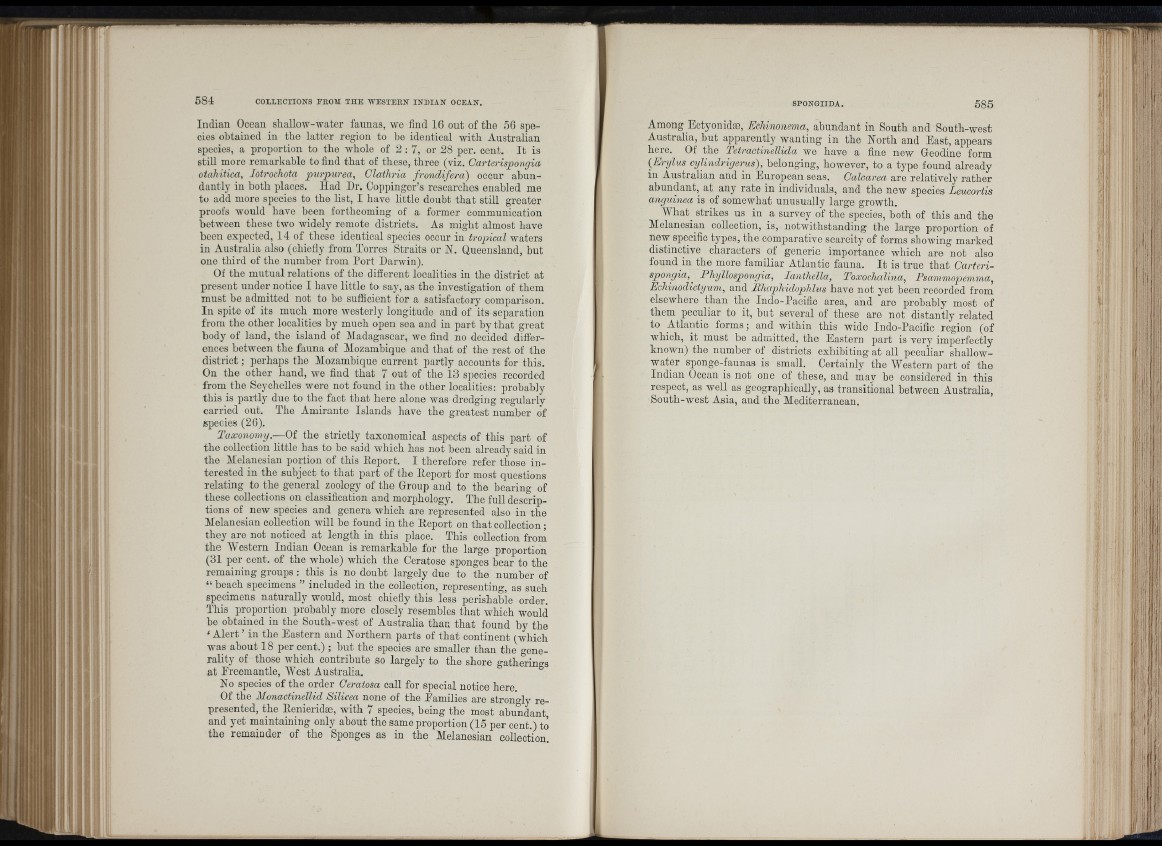
Indian Ocean sliallow-water faunas, wo find 16 out of the 56 species
obtained in the latter region to be identical with Australian
species, a proportion to the whole of 2 : 7 , or 28 per. cent. I t is
still more remarkable to find th at of these, three (viz. Carterispongia
otahitica, lotrochota purpurea, Clathria frondifera) occur abundantly
in botb places. Had Dr. Coppingor’s researches enabled me
to add more species to tbe list, I have little doubt th at still greater
proofs would have been forthcoming of a former communication
between these two widely remote districts. As might almost bave
been expected, 14 of these identical species occur in tropical waters
in Australia also (chiefly from Torres Straits or N. Queensland, but
one third of the number from Port Darwin).
Of tbe mutual relations of the different localities in tbe district at
present under notice I bave little to say, as tbe investigation of them
must be admitted not to be sufficient for a satisfactory comparison.
In spite of its much more westerly longitude and of its separation
from the otber localities by much open sea and in part by th at great
body of land, tbe island of Madagascar, we find no decided differences
between the fauna of Mozambique and th at of the rest of tbe
d is tric t; perhaps the Mozambique current partly accounts for this.
On the other hand, wo find th at 7 out of the 13 species recorded
from tbe Seychelles were not found in the otber localities: probably
tbis is partly due to the fact th at here alone was dredging regularlv
carried out. The Amirante Islands have tbe greatest number of
species (26).
Taxonomy.—Of tbe strictly taxonomical aspects of tbis part of
the collection little has to bo said which bas not been already said in
the Melanesian portion of tbis Eeport. I therefore refer those in terested
in tbe subject to th at part of the Eeport for most questions
relating to tbe general zoology of tbe Group and to tbe bearing of
these collections on classification and morphology. The full descriptions
of new species and genera which are represented also in tbe
Melanesian collection will be found in the Eeport on th at collection;
they aro not noticed at length in tbis place. Tbis collection froin
the AArostern Indian Ocean is remarkable for the large proportion
(31 per cent, of tbe whole) which the Ceratose sponges bear to tbe
remaining groups : this is no doubt largely due to tbe number of
“ beach specimens ” included in the collection, representing, as such
specimens naturally would, most chiefly this less perishable order.
Tbis proportion probably more closely resembles th at wbicb would
be obtained in tbe South-west of Australia than th a t found by tbe
‘ Alert ’ in tbe Eastern and Northern parts of th at continent (which
was about 18 per cent.) ; but tbe species are smaller than the generality
of those which contribute so largely to tbe shore gatherings
a t Ereemantle, AVest Australia.
No species of tbe order Ceratosa call for special notice here.
Of the Alonactinellid Silicea none of tbe Eamilies are strongly represented,
tbe Eenieridse, witb 7 species, being the most abundant,
and yet maintaining only about the same proportion (15 per cent.) to
tbe remainder of tbe Sponges as in tbe Melanesian collection.
L
Among Ectyonidæ, Echinonema, abundant in South and South-west
Australia, but apparently wanting in tbe North and East, appears
here. Of the Tetractinellida we have a fine new Geodine form
{Erylus cylindrigerus), belonging, however, to a type found already
in Australian and in European seas. Calcarea are relatively rather
abundant, at any rate in individuals, and the new species Leucortis
anguinea is of somewhat unusually large growth.
AVhat_ strikes us in a survey of tho species, both of tbis and tbe
Melanesian collectiou, is, notwithstanding the largo proportion of
new specific types, the comparative scarcity of forms showing marked
distinctive characters of generic importance which are not also
found in tbe more familiar Atlantic fauna. I t is true th at Carterispongia,
^ Phyllospongia, lanthella, Toxochalina, Psammopemma,
Echinodictyum, and Rhaphidophlus bave not yet been recorded from
elsewhere than the Indo-Pacific area, and are probably most of
them peculiar to it, but several of these are not distantly related
to Atlantic forms; and within this wide Indo-Pacific region (of
wbicb, it must be admitted, the Eastern part is verj' imjierfectly
known) the number of districts exhibiting at all peculiar shallow-
water sponge-faunas is small. Certainly the AVestern part of the
Indian Ocean is not one of these, and may be considered in this
respect, as well as geographically, as transitional between Australia,
South-west Asia, and the Mediterranean.
i'i''I i'
, i r i